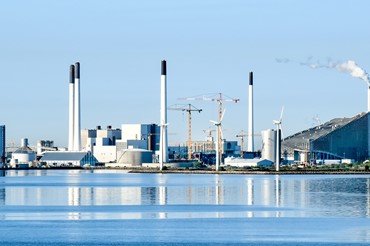When we for example convert green energy to methanol, we have to use methane gas (biogas), CO2 and hydrogen. Let’s begin with the CO2 part. Most people know that too high concentrations of CO2 in our atmosphere are harmful and part of the reason why our planet is slowly heating up. CO2 can be created, when we burn fossil based waste, such as diapers or wellies, or when we produce biogas.
In a study that my colleagues and I conducted with Amager Ressource Center (ARC), which is a large waste treatment plant servicing the Greater Copenhagen area, we researched the optimum ways in which we can minimize the CO2-emissions from the flue gas that is emitted from ARC’s chimney.
Flue gas has a CO2-concentration of about 10 per cent, and this CO2 can be captured with existing technologies. Our technology screening showed that capturing CO2 from flue gas is best done with absorption technology. The flue gas is ‘washed’ with an amine solution, which can absorb the CO2 and release it again in a container, when we change the pressure and temperature.
Hydrogen holds it together
Don’t worry if the technicalities described above throw you off a little bit. It’s sufficient to remember that we can capture the CO2, and that we can create something useful from it after capturing it. Aside from capturing CO2 from flue gas, we are also able to harvest and utilise CO2 that we find in biogas, waste gas, in the sea, and in some instances, directly from the atmosphere.
If we want to utilise the CO2 after capturing it, we have to use hydrogen. Hydrogen is the most common element on our planet, but it is not found in free form. This is why we need to release the hydrogen first. We do this with the help of electrolysis; A process in which water is split into oxygen and hydrogen using green electricity. This green electricity is of course the energy that we just defined as our Power-element in PtX.
Now we are getting to the core of what PtX is and can do for us: once the hydrogen is released, we can combine it with the captured CO2. Subsequently, with the help of fairly simple, chemical processes -of which I will spare you the details- we can convert the two components into sustainable aviation fuel, methanol or something third.
This means that we – formulated in a popular manner – can convert windy weather and air pollution into fuel to supply sectors that traditionally are very polluting.
Flying without shame
I can offer you an example about sustainable aviation fuel. A study conducted by NIRAS in close cooperation with Syddansk Universitet and Nordic Initiative for Sustainable Aviation shows that it will be feasible to commercially produce climate-friendly aviation fuel by using PtX technology within five to ten years.
The undeniable beauty of fuels produced with the help of PtX is that they are not emitting fossil CO2 when used as fuel for planes, cars or ferries. PtX-produced fuels are also called e-fuels or synthetic fuels. Synthetic fuels also have the advantage that they can power the type of motors that are installed in the planes, cars and ferries we use today, so all motor-powered vehicles can start using these fuels straight away.
A follow-up study, released in January 2020, shows that multiple Scandinavian airlines have begun to experiment with sustainable aviation fuel. This development is joyous, because all the steps in the production process of sustainable aviation fuel can potentially be sustainable and useful, enabling us to explore the world without a bad conscience or ‘flight shame’.
Why now?
“Yeah okay,” you might think, “so what’s the catch? Because if all of the above is as marvellous as you describe, then why haven’t we implemented it yet?”
This is a good and relevant question. There are multiple reasons as to why we aren’t using PtX to its full potential yet. First of all, we need a demand and that is coming now. No one wants to start production, if there aren’t any customers.
Another reason we don’t see PtX everywhere is that until now, we haven’t had enough sustainable energy sources that can help us produce green hydrogen. We have to use rather large amounts of hydrogen in the conversion process and without green hydrogen, there can be no green end products.
But with the help of big, newly released projects, such as for example the participation of Danish energy company Ørsted in erecting wind mills to produce green hydrogen, we will soon be in a better position to quicken the pace of the green transition with PtX.
A final constraining factor has been the political agenda. Politicians, both on national and international levels, have been hesitant to set daring green agendas. Fortunately, many governments on a global level are now beginning to implement binding green initiatives. This results in ambitious climate programs, such as the Danish government committing themselves to CO2-neutrality in 2050.
Support from businesses
All of the above has caused PtX to be expensive and not commercially viable for many companies. But the momentum is here – a development that causes the PtX price tag to shrink. Right now, green energy solutions only cost 1.5-2 times as much to implement as solutions based on fossil energy. In other words: sustainable solutions are becoming competitive.
We have for example been contacted by a company that produces glue. They are interested in using PtX to make their glue production sustainable. We will look into PtX-solutions for them.
Power-to-X is ready to be commercially exploited. Let’s get started with the production of sustainable fuels based on ‘windy weather and air pollution’, so we can keep on flying, exploring the seas, and exporting products in the global market place without polluting and without any shame.
Read more:
Find the study conducted by NIRAS, Syddansk Universitet and Nordic Initiative for Sustainable Aviation here.





